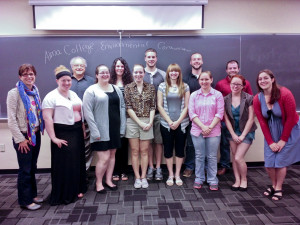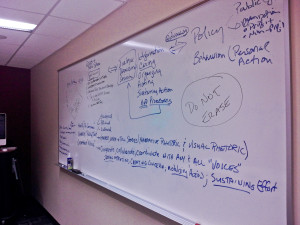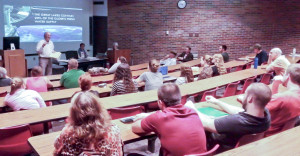A letter sent to the Pipeline and Hazardous Materials Safety Administration included with the authorized signatures of…
Anglers of the Au Sable • Clean Water Action • Detroit Riverkeeper • Dwight Lydell Chapter Izaak Walton League of America • FLOW (For Love of Water) • Friends of the AuGres-Rifle Watershed • Flint River Watershed Coalition • Friends of The Boyne River • G.R.E.A.T (Grand River Environmental Action Team) • Grand Valley Metro Council • Great Lakes Council of the International Federation of Fly Fishers, Inc. • Great Lakes Environmental Law Center • Gull Lake Quality Organization • Huron River Watershed Council • Les Cheneaux Watershed Council • Michigan Environmental Council • Save the Wild U.P. • Michigan Land Use Institute • Michigan League of Conservation Voters • Michigan Trout Unlimited • Miller-Van Winkle Chapter Trout Unlimited • Muskegon River Watershed Assembly • Saginaw Field and Stream Club • National Wildlife Federation • respectmyplanet.org • • Sierra Club Michigan Chapter • Sturgeon For Tomorrow •The Watershed Center ~ Grand Traverse Bay • Tip of the Mitt Watershed Council • Upper Black River Council • Upper Peninsula Environmental Coalition • West Michigan Environmental Action Council
The Honorable Cynthia I. Quarterman
Administrator Pipeline and Hazardous Materials Safety Administration
U.S. Department of Transportation
East Building, 2nd Floor
1200 New Jersey Ave.,SE
Washington, DC 20590
Director Linda Daugherty
Pipeline and Hazardous Materials Safety Administration
Office of Pipeline Safety
Central Region Office
901 Locust Street, Suite 462
Kansas City, MO 64106
July 7, 2014
RE: Water Crossing Survey of Michigan Pipelines
Dear Administrator Quarterman and Director Daugherty:
The undersigned organizations hereby request that the United States Department of Transportation, Pipeline and Hazardous Materials Safety Administration (PHMSA) conduct a water crossing study to evaluate the risk of ruptures and leaks in all sections of pipeline that cross Michigan’s rivers, streams, and lakes.
The Great Lakes represent one-fifth of the world’s fresh surface water. Forty million people rely on the Great Lakes for their drinking water, and millions more benefit from the commerce and business that depend on the waters of the Great Lakes.
Michigan is the Great Lakes state with more freshwater coastline than any other state in the nation. Our lakes, rivers, and streams define not only our boundary but also provide a path to environmental, economic, and social progress. The health of the people of Michigan, our economy, and our quality of life depends on clean water. The Great Lakes ecosystem provides unparalleled recreational and economic opportunities to the 10 million people that call Michigan home. Studies show that the Great Lakes provide Michigan with 823,000 jobs that represent nearly 25 percent of Michigan’s payroll. Additionally, Great Lakes tourism generates billions of dollars each year from those who spend leisure time around our lakes and streams.
Pipelines crossing Michigan’s rivers, streams, and Great Lakes put these resources at risk – threatening our health and economic viability. These treasures demand increased attention from the Pipeline and Hazardous Material Safety Administration to accomplish its pipeline safety mission by ensuring the safety of pipeline crossings in Michigan waterways.
We request that PHMSA conduct a water crossing survey of Michigan pipelines to:
- Develop a comprehensive map of pipeline waterway crossings;
- Determine the status of all existing pipelines running underneath Michigan’s water bodies;
- Evaluate the pipeline integrity and risk of ruptures and leaks at each pipeline crossing; and
- Outline what should be done to prevent future pipeline failures.
We request that PHMSA review all the documentation necessary to determine the status of all pipelines running under Michigan’s rivers, streams, and lakes. PHMSA should analyze and critique the structural integrity of each pipeline and the standards required at the time of installation of each pipeline to assess the risk of ruptures and leaks. The review should include a variety of factors including each pipeline’s age, thickness, and degree of corrosion; the condition and operation of all shut-off valves; the valve distances from the streams or rivers; what products the pipelines are carrying; the pipeline diameters and burial depth; and what pressures the pipeline products are under. It should also include identification of any critical information gaps that exist in the pipeline network within Michigan.
In addition, PHMSA should work directly with pipeline operators to complete the water crossing survey. PHMSA should request any and all information related to structural integrity and potential risks from pipeline operators whose infrastructure crosses a river, stream, or lake. PHMSA should also require that companies fill any critical information gaps found during the analysis. This may prompt operators to perform in-depth studies/analyses on all their major pipeline water crossings. All of this information can then be used to make recommendations to prevent any future failures that damage Michigan’s pristine rivers, streams, and lakes.
The state has various programs related to the regulation of pipelines. However, the Michigan Public Service Commission (MPSC) is the only state agency with direct regulatory authority over safety of pipelines. The MPSC’s authority is restricted to natural gas pipelines. All other safety-related authority, including jurisdiction of hazardous liquid pipelines, rests with PHMSA and preempts state regulation of safety factors. Therefore, it is incumbent upon PHMSA to fulfill its mandate and conduct a study to ensure the protection of Michigan’s citizens and environment from the risks that are inherent in the transportation of hazardous materials by pipeline.
The Great Lakes and inland waters are Michigan’s natural resource treasures; they shape our state, our lives, and our economy. The waters of Michigan have already suffered as a result of a July 26, 2010 pipeline rupture that released an estimated 843,000 gallons of crude oil into Talmadge Creek and the Kalamazoo River, a Lake Michigan tributary. It is imperative that history not be repeated elsewhere in Michigan. It is critical to ensure the integrity of pipelines at major water crossings that affect rivers, streams, and lakes in Michigan. To do this, PHMSA must compile a comprehensive inventory of pipelines at water crossings and determine if they are currently safe.
Therefore, the undersigned organizations formally request that the United States Department of Transportation, Pipeline and Hazardous Materials Safety Administration conduct a water crossing survey of Michigan pipelines.
If you have any questions regarding this request or would like to discuss further, please contact Jennifer McKay at Tip of the Mitt Watershed Council at (231) 347-1181 or by email at jenniferm@watershedcouncil.org.
Sincerely,
Bruce Pregler President Anglers of the Au Sable
Nic Clark Michigan Director Clean Water Action
Robert Burns Detroit Riverkeeper
Duane De Vries President Dwight Lydell Chapter Izaak Walton League of America
Rebecca Fedewa Executive Director Flint River Watershed Coalition
Liz Kirkwood Executive Director FLOW (For Love of Water)
Jacque Rose Co-Founder Friends of the AuGres-Rifle Watershed
Carl J Wehner President Friends of The Boyne River
Kenny Price President G.R.E.A.T (Grand River Environmental Action Team)
Wendy Ogilvie Director of Environmental Programs Grand Valley Metro Council
Jim Schramm President Great Lakes Council of the International Federation of Fly Fishers, Inc.
Nick Schroeck Executive Director Great Lakes Environmental Law Center
Susan Houseman Vice President Gull Lake Quality Organization
Laura Rubin Executive Director Huron River Watershed Council
G.K. Herron Treasurer Les Cheneaux Watershed Council
James Clift Policy Director Michigan Environmental Council
Hans Voss Executive Director Michigan Land Use Institute
Erica Bloom Policy Manager Michigan League of Conservation Voters
John Walters Vice Chairman Michigan Trout Unlimited
Gregory Walz President Miller-Van Winkle Chapter Trout Unlimited
Gary A. Noble Executive Director Muskegon River Watershed Assembly
Andy Buchsbaum Director, Great Lakes Office National Wildlife Federation
Matt Wandel Founder & Managing Director respectmyplanet.org
Alexandra Thebert Executive Director Save the Wild U.P.
Anne Woiwode State Director Sierra Club Michigan Chapter
Brenda Archambo President Sturgeon For Tomorrow
Christine Crissman Executive Director The Watershed Center ~ Grand Traverse Bay
Gail Gruenwald Executive Director Tip of the Mitt Watershed Council
Carol Moncrieff Rose Chair Upper Black River Council
Nancy Warren Acting President Upper Peninsula Environmental Coalition
Nicholas Occhipinti, MPP Policy and Community Activism Director West Michigan Environmental Action Council
Mike Meyer President Saginaw Field and Stream Club
cc: Rick Snyder, Governor, State of Michigan
Dan Wyant, Director, Michigan Department of Environmental Quality
Bill Schuette, Attorney General,
State of Michigan State of Michigan Congressional Delegation
Allan Beshore, CATS Manager, PHMSA Harold Winnie, CATS Manager, PHMSA
Harold Winnie, CATS Manager, PHMSA





